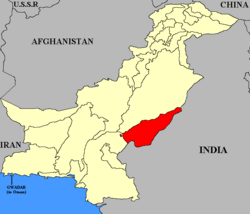Bahawalpur (princely state)
| State of Bahawalpur ریاستِ بہاولپور |
||||||
| Semi-autonomous domain of Mughal Empire, Durrani Empire and the British Empire | ||||||
|
||||||
|
||||||
| Bahawalpur State in the Imperial Gazetteer of India | ||||||
| Capital | Bahawalpur | |||||
| Government | Principality (1690–1955) | |||||
| Nawab Amir of Bahawalpur | His Highness Nawab Mohammad Bahawal Khan Abbasi (first) | |||||
| • | 1907 to 1966 | His Highness General Nawab Sadiq Muhammad Khan Abbasi V (last) | ||||
| Prime Minister of Bahawalpur | ||||||
| • | 1942–1947 | Sir Richard Marsh Crofton(first) | ||||
| • | 1952 - 14 October 1955 | A.R. Khan (last) | ||||
| Historical era | Mughal Empire (1802–1858) Indian British Empire (22 February 1858-1947) Princely state of Pakistan (1947-1955) Part of West Pakistan (1955-1970) Punjab, Pakistan (1970-present) Dividing between the Bahawalpur District, Bahawalnagar District and the Rahim Yar Khan District. | |||||
| • | Established | 1802 | ||||
| • | Merged into West Pakistan | 14 October 1955 | ||||
| Today part of | Pakistan, India | |||||
| Bahawalpur | |||||
| Subdivision of Pakistan | |||||
|
|||||
|
Flag |
|||||
| Map of Pakistan with Bahawalpur highlighted | |||||
| Capital | Bahawalpur | ||||
| History | |||||
| • | Established | 1947 | |||
| • | Disestablished | 14 October 1955 | |||
| Area | 45,911 km2(17,726 sq mi) | ||||
Flag
Bahawalpur was a princely state of British India and later, Pakistan, that existed from 1802 to 1955. It was a part of Punjab States Agency. The state covered an area of 45,911 km² (17,494 sq mi) and had a population of 1,341,209 in 1941. The capital of the state was the town of Bahawalpur.
Bahawalpur state was founded in 1802 by Nawab Mohammad Bahawal Khan Abbasi after the breakup of the Durrani Empire. His successor was Nawab Mohammad Bahawal Khan Abbasi III. On 22 February 1833, Abbasi III entered into subsidiary alliance with the British by which Bahawalpur was admitted as a princely state of British India. When India became independent of British rule in 1947 and partitioned into two states, India and Pakistan, Bahawalpur joined the Dominion of Pakistan. Bahawalpur remained an autonomous entity till 14 October 1955 when it was merged with the province of West Pakistan.
The Abbasi tribe from whom the ruling family of Bahawalpur belong, claim descent from the Abbasid Caliphs. The tribe came from Sindh to Bahawalpur and assumed independence during the decline of the Durrani Empire. Bahawalpur along with other Cis-Sutlej states were a group of states, lying between the Sutlej River on the north, the Himalayas on the east, the Yamuna River and Delhi District on the south, and Sirsa District on the west. These states were ruled by the Scindhia dynasty of the Maratha Empire, various Sikh sardars and other Rajas of the Cis-Sutlej states paid tributes to the Marathas, until the Second Anglo-Maratha War of 1803-1805, after which the Marathas lost this territory to the British.
...
Wikipedia





